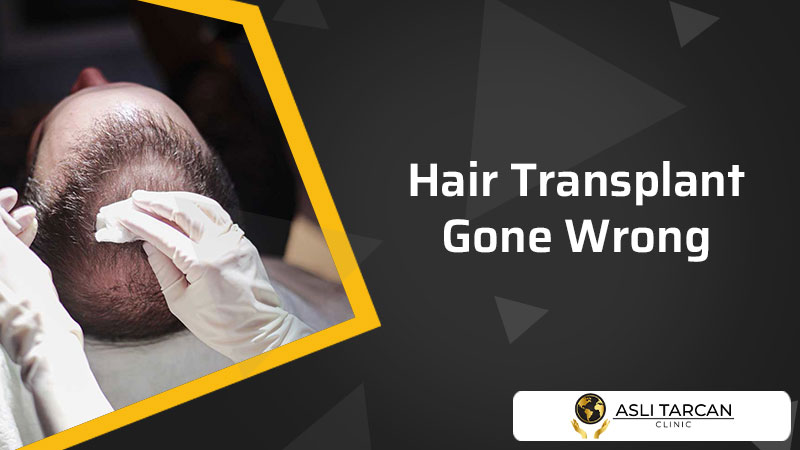Hair Transplant Gone Wrong
There are a few scenarios in which a hair transplant gone wrong. Especially if the patient is in good health and follows the hair transplant surgeon’s pre- and post-operative instructions. The ultimate result of the vast majority of hair transplants should be quite similar to what was discussed during the initial consultation between the doctor and the patient. During this time, the doctor will also be able to detail any potential issues that may occur as a result of the patient’s unique ailments. The scarcity of donor tissue, for example, may make it difficult to obtain the desired level of coverage at the recipient location.
Can A Hair Transplant Hair Transplant Gone Wrong?
Although it is extremely unusual for a whole hair transplant to “fail,” a tiny proportion of the transplanted follicular units may fail to take root and so fail to create new hair growth. Skilled surgeons; the majority of patients get a near-100 percent success rate as a consequence of the transplant, with just 5% of follicular unit grafts failing. This is especially true for surgeons who work with a team of nurses and surgical assistants, as the most prevalent cause of follicular unit failure is drying. When follicular unit transplants spend too much time outside of the body, this happens.
Although a complete hair transplant is exceedingly rare, a small percentage of the transplanted follicular units may fail to take root and so fail to produce new hair growth. Expert surgeons; the majority of patients have a near-100 percent success rate after the transplant. With only 5% of follicular unit grafts failing. The most common reason of follicular unit failure is drying. This is especially true for surgeons who operate with a team of nurses and surgical assistants. This happens when follicular unit transplants spend too much time outside of the body.
What Are The Common Problems That Make A Hair Transplant Wrong?
It’s not realistic to call any complication with a hair transplant “common” without a qualification such as “relatively”. Hair transplants are extremely successful and give consistent, predictable outcomes, thanks to the ongoing advancement of new technology and methods. This is especially true for individuals who choose a reputed hair transplant center and an experienced specialist. The most common problem found during the hair transplant procedure. Due to variables beyond the doctor’s control, such as the lack of sufficient donor tissue.
Despite the fact that the majority of specialists throughout the world can hide the scar. Patients who have had FUT treatments in the past may desire to have the scar amended or rectified through an extra procedure. Patients who had a FUT procedure before recent advances in medical technology or who want to change their hairstyle to a shorter one are the most likely to seek scar revision procedures. As the horizontal scar left behind after a FUT procedure is now relatively easy to cover up with the patient’s own, naturally growing hair.
The best method to deal with any possible hair transplant issue is to seek the help of an experienced and renowned hair transplant surgeon with a proven track record of success in executing hair transplant surgeries. This includes issues such as insufficient covering or a botched hair transplant when far too many grafts fail to take root in the patient’s recipient location.
Can Hair Transplant Problems Be Corrected?
Every patient who undergoes a medical treatment is different, and as a result, they may heal differently than others. This simple feature may make the horizontal scar left by FUT more obvious than they wanted. Particularly in patients who had FUT or other hair restoration surgeries many years before medical technology made it feasible to leave a considerably less visible scar. Patients who have a noticeable hair transplant scar can choose from a variety of procedures for hair transplant scar revision or repair. They are including the following:
- Micropigmentation of the scalp
- Dermal fillers are a kind of dermal filler that is
- Injections of cortisone or corticosteroids
- Dermabrasion
- Excision
Because the most successful course of action for hair transplant scar revision or correction may vary depending on a variety of factors. It is usually advisable for a patient to discuss the various choices with a qualified hair transplant surgeon during an initial appointment at a hair transplant clinic. Dermal fillers, for example, maybe the best way to treat a scar that seems concave. A cortisone injection may be particularly beneficial for a thick or elevated scar.
Scalp micro pigmentation is becoming a more common choice for hair transplant scar revision or repair. Since it is the most adaptable and effective of the aforementioned procedures. This non-invasive, non-surgical method entails injecting a particular pigment at a shallow depth. This mimics the look of naturally growing hair and so obscures the scar, making it unnoticeable.
How To Fix A Failed Hair Transplant?
Patients who have insufficient covering, but enough donor tissue can simply fix their hair transplant issue with future FUE or FUT operations. Also, patients who require numerous sessions of hair restoration should. Of course, have disclosed their need for more than one transplant during the first consultation procedure. However, this is not usually the case.
Patients who are unhappy with the results of their hair transplant. Because the grafts did not take root might have further sessions to obtain the coverage they desired. Hence, it is assuming that there is still enough donor tissue available for future treatments. In order to avoid a recurrence of the problem, these patients should seek the advice of an experienced hair transplant surgeon at a hair transplant clinic to determine the cause of the original hair transplant failure.
Hair transplant operations are aimed to give patients a natural-looking hairline and thick head of hair, restoring self-confidence and self-esteem. A botched hair transplant will not achieve any of these goals and in many circumstances. So, it will make the patient feel much more insecure than before. This is why it’s critical to enlist the help of a skilled and knowledgeable hair transplant surgeon from the start. So that you don’t have to worry about how to fix a botched hair transplant afterward.
Hair Transplantation FUE Procedure
The hair transplantation FUE procedure has been revolutionizing the hair loss treatment industry for many years, and the results can be quite remarkable. After your procedure, it is important to follow all of the post-operative instructions that are provided in order to ensure that you are able to achieve and maintain optimal results. This includes getting adequate rest and avoiding strenuous activities, following a healthy lifestyle and diet, avoiding harsh styling products, and using special care while washing your hair. Visit a hair transplant doctor in this treatment so they can discuss different options tailored specifically for you based on your individual needs and lifestyle. Additionally, consulting with your doctor if you suffer from any complications or have any questions regarding your progress is highly recommended.

Taking these measures will help you achieve the best possible outcome from your hair transplantation procedure of FUE. By properly taking care of yourself after undergoing a hair transplantation FUE procedure, you can enjoy long-lasting results for many years to come. With proper maintenance, some patients have seen visible improvement even several months after their surgery has been completed. With advances in modern technology, FUE hair transplant has become increasingly popular as an effective way of restoring lost hair.



